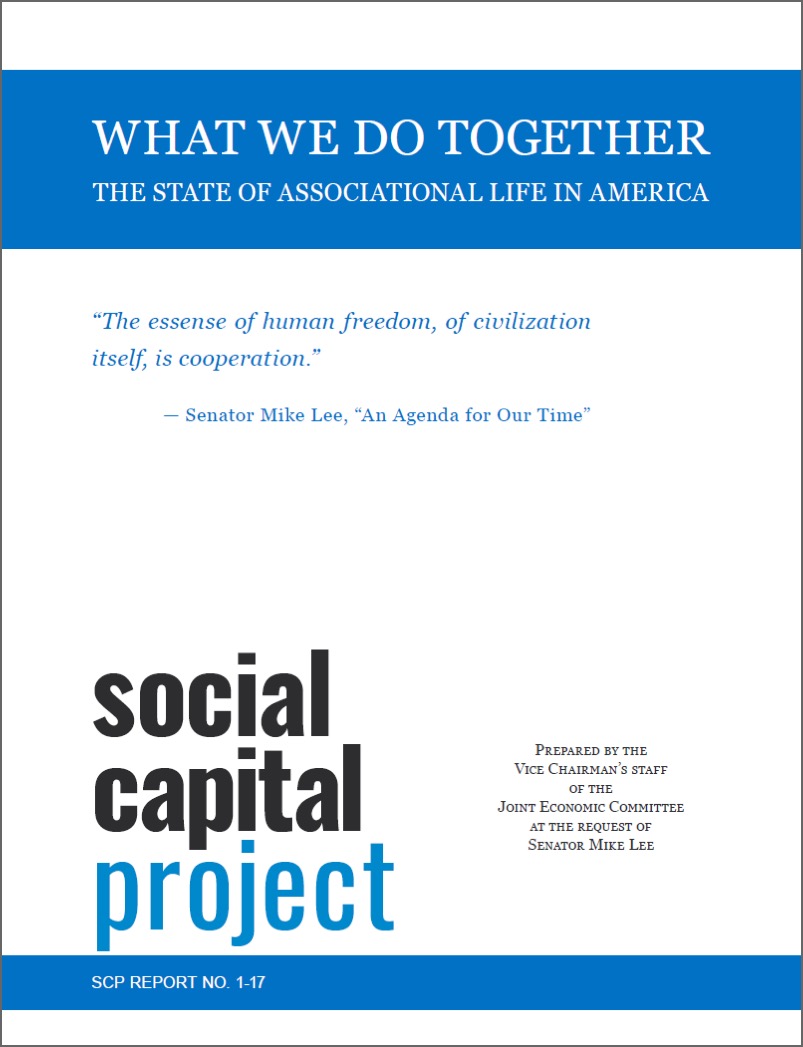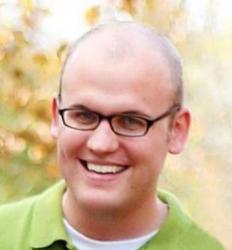Over the past few decades, America has experienced a wave of drastic economic and social disruption. In our search for solutions, we’ve tended to look either to ourselves or the State, resulting in a clash between individualism and collectivism that forgets or neglects the space between.
But what might be happening (or not happening) in those middle layers of society, from families to churches to charities to our economic activities? What might we be missing or forgetting about in those mediating institutions that, up until now, have held our country together?
Those basic questions are at the center of a recent crop of popular books, from Robert Putnam’s Bowling Alone to Charles Murray’s Coming Apart to Yuval Levin’s The Fractured Republic, leading many to re-focus their attention on bottom-up, community-based solutions. And now, they’re getting a bit more attention from the halls of political power.
This week, Sen. Mike Lee launched the Social Capital Project, a multi-year research project dedicated to investigating those same questions on “evolving nature, quality, and importance of our associational life.” “In Washington, we measure GDP, we measure government outlays and revenues — all kind of things that are quantifiable and monitored like vital signs, blood pressure and heart rate,” says Lee. “But we don’t always take the time to measure other things that are just as important to our life as a country.”
The project aims to accomplish precisely that:
“Associational life” is our shorthand for the web of social relationships through which we pursue joint endeavors—namely, our families, our communities, our workplaces, and our religious congregations. These institutions are critical to forming our character and capacities, providing us with meaning and purpose, and for addressing the many challenges we face.
The goal of the project is to better understand why the health of our associational life feels so compromised, what consequences have followed from changes in the middle social layers of our society, why some communities have more robust civil society than others, and what can be done—or can stop being done—to improve the health of our social capital. Through a series of reports and hearings, it will study the state of the relationships that weave together the social fabric enabling our country—our laws, our institutions, our markets, and our democracy—to function so well in the first place.
In its first report, titled “What We Do Together,” the project highlights the profound connections between “associational life” and the nation’s economic success.
 As the report details, those intricate ties between family, religion, community, and work represent a feature of American life that stretches well into its past. When Alexis de Tocqueville visited the United States in the nineteenth century, he was startled by the peculiar unity that Americans found amid those diverse and intersecting relationships. “Americans of all ages, all conditions, all minds, constantly unite,” Tocqueville wrote. “Not only do they have commercial and industrial associations in which all take part, but they also have a thousand other kinds: religious, moral, grave, futile, very general and very particular, immense and very small.”
As the report details, those intricate ties between family, religion, community, and work represent a feature of American life that stretches well into its past. When Alexis de Tocqueville visited the United States in the nineteenth century, he was startled by the peculiar unity that Americans found amid those diverse and intersecting relationships. “Americans of all ages, all conditions, all minds, constantly unite,” Tocqueville wrote. “Not only do they have commercial and industrial associations in which all take part, but they also have a thousand other kinds: religious, moral, grave, futile, very general and very particular, immense and very small.”
Or, as Don Eberly puts it (quoted in the report), those same civic functions “served to cultivate democratic habits and skills,” mitigating the temptations toward isolated individualism and whole-hearted worship of the state. “In the truest sense, they were laboratories of democracy,” he writes. “Local civic associations put democracy within people’s reach, inculcating the customs and many uses of democratic process, tempering self-interest and isolation.”
Drawing from that same intellectual tradition, the report concludes that there are three key reasons why associational life is so important for America’s success (the categories are my own paraphrase, but the rest is quoted directly):
1. Social, moral, and spiritual development
First, the middle social layers are implicated in nearly every aspect of our lives, and therefore are critically important formative structures in which human development occurs. What we do together affects our character, capacities, deepest held moral commitments, and any number of other aspects of who we are.
2. Finding meaning and purpose
Second, mediating institutions provide an important role in giving meaning and purpose to individual lives. “Meaning” and “purpose” are words that give hives to empirically minded social scientists, but nonetheless deserve our attention. Jointly pursuing common goals—prosaic or profound—draws people out of themselves, gives them a reason to get up in the morning, and to be responsive to the needs of others. When people lack the meaning and purpose derived from strong bonds and routine social attachments, they are more prone to alienation and atomization. Along these lines, David Brooks has argued, “The great challenge of our moment is the crisis of isolation and fragmentation, the need to rebind the fabric of a society that has been torn by selfishness, cynicism, distrust, and autonomy.”
3. Discovering solutions (social / economic / political)
The third reason our middle social layers are so important, especially today, is that they provide a useful means for discovering solutions to problems. The large institutions of our modern society, polity, and economy are often ill-equipped to address needs that are unique to the particular “circumstances of time and place.” They are sometimes too far removed from local sources of knowledge and networks of trust, and they can be slow to adapt as problems evolve. Some can be out of touch with the values of specific places, breeding resentment and fueling regional polarization. As many analysts have concluded, decentralizing authority and decision-making capacity to our middle layers might go a long way to increasing America’s ability to address challenges incrementally through trial and error in ways that are much closer to the people and their varied situations.
The report proceeds to document a storm of statistical trends in each of those categories (family, religion, community, and work), demonstrating just how drastic the shifts actually are, from marriage rates to religious involvement to neighborhood sociability to workforce participation.
“The connective tissue that facilitates cooperation has eroded,” the report concludes, “leaving us less equipped to solve problems together within our communities,” and more likely to turn to the state (or cynicism).
The solution, as should be obvious, is not prone to quick-and-fast policy grabs or coercive social engineering. Neither is emphasizing the “middle layers” an easy antidote for the problems of our age. And yet reorienting our attitudes and actions is a beginning.
In each of our lives — whether in our families, churches, communities, or workplaces — we have the opportunity to proceed with gradual, long-term “repairs” — mending the fabric of civilization not through sweeping rhetoric about policy solutions, but through mundane faithfulness in our respective spheres.
“An emphasis on the middle layers of our social life is no panacea for the many challenges and opportunities we face,” the report concludes. “But in an era where many of our conversations seem to revolve around the individual and large institutions, an emphasis on the space between them could bring many benefits.”
Image: The County Election, painting by George Caleb Bingham (1852)

